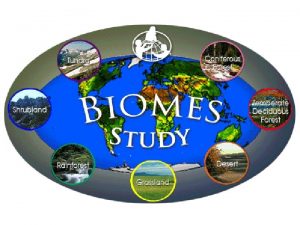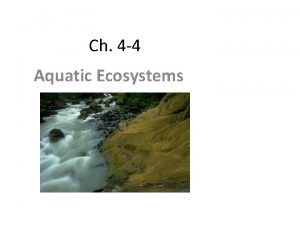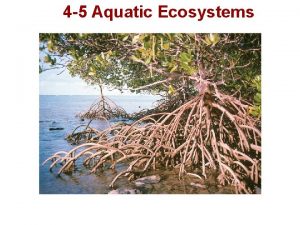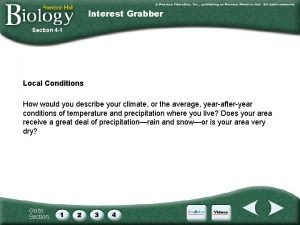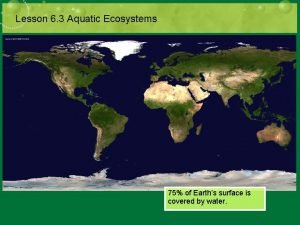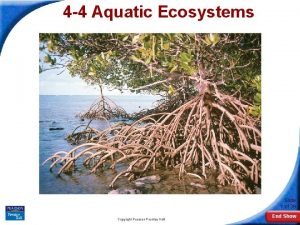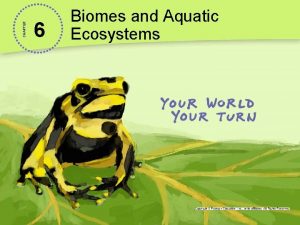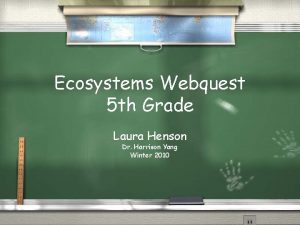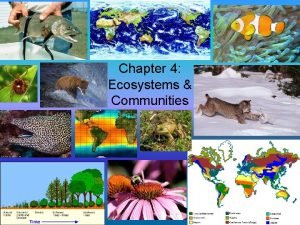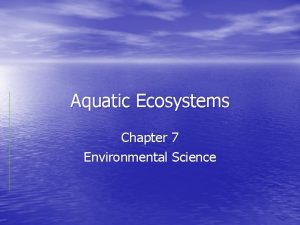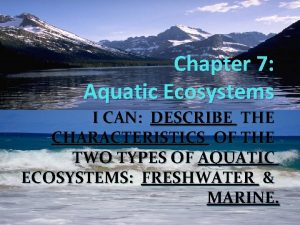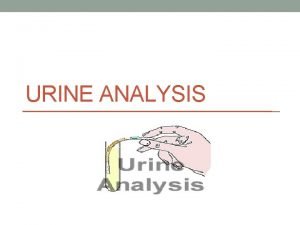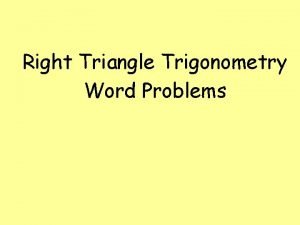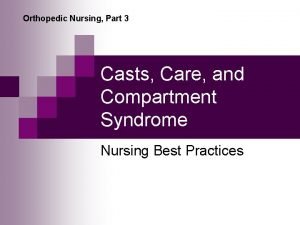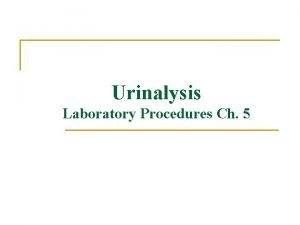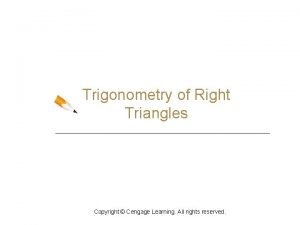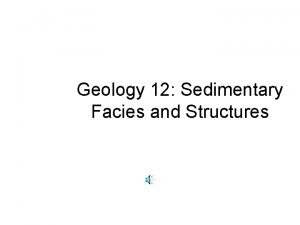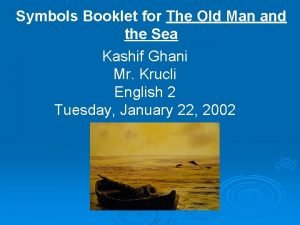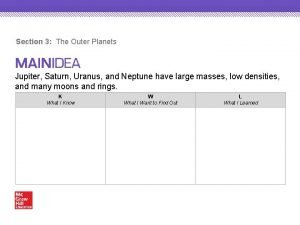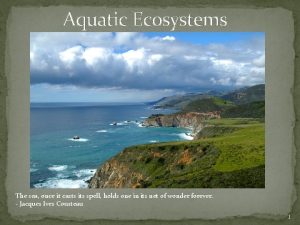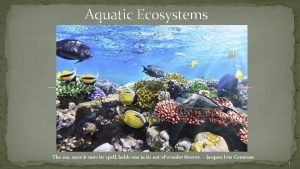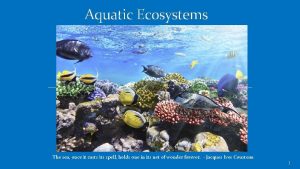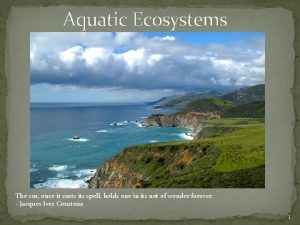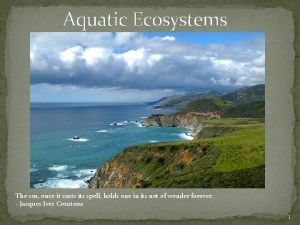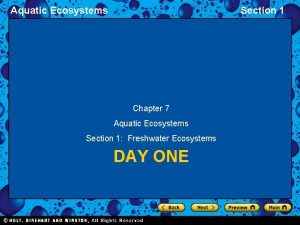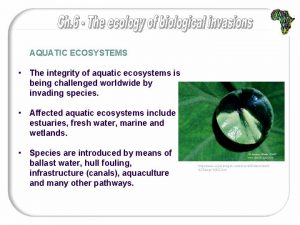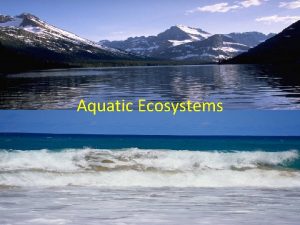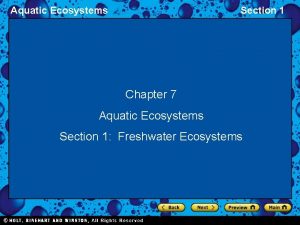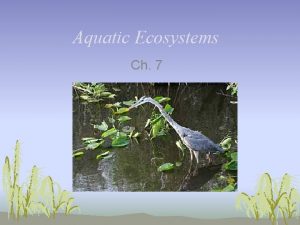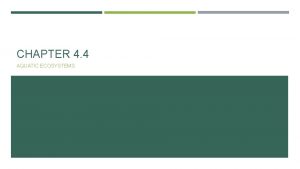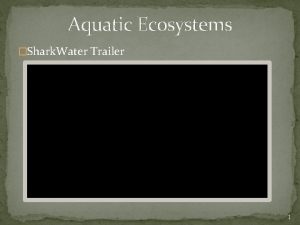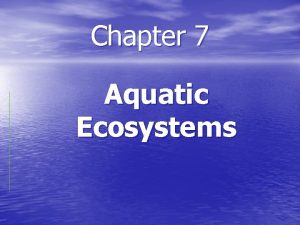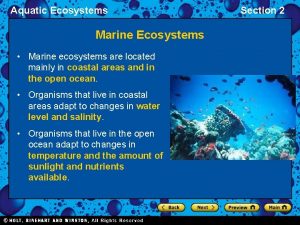Aquatic Ecosystems The sea once it casts its






















































- Slides: 54

Aquatic Ecosystems The sea, once it casts its spell, holds one in its net of wonder forever. - Jacques Ives Cousteau 1

Earth’s water � 71% of Earth is covered by water �If 100 ml represents ALL of the water: 97. 2 % is in oceans 2. 8% is fresh 2. 3% is in ice caps (46 drops) . 387% is in ground water (8 drops) . 022% is in surface water (. 4 drops) . 001% is in atmosphere (. 1 drop) 2

Aquatic Ecosystems �Aquatic ecosystems, like those on land, have a series of abiotic factors that influence what organisms can survive where. �Water temperature �Amount of sunlight �Availability of dissolved oxygen gas in the water. �Nutrients such as nitrates and phosphates. �Turbidity, or the cloudiness of the water. �salinity 3

6. Salinity �Concentration of salt, measured in parts per thousand (ppt) �Oceans are 30 -50 ppt �Fresh water is. 5 or less ppt �Brackish water is. 5 -30 ppt �How do fish deal? �In salt water, use ATP energy to pump salt out via gills and kidneys (salty pee) �In freshwater, fish constantly pee to battle osmosis �Euryhaline fish can live in either! Eels, salmon 4

Biotic Factors �Life in aquatic ecosystems falls within these types: �Plankton, which are free- floating or weakly swimming. �Phytoplankton are plant- like and include algae. �Zooplankton are animallike, including organisms like single-celled protozoa or jellyfish. �Nekton are strong swimmers and consumers. Fish, whales, sea turtles, etc. 5

Aquatic Ecosystem Organisms ~Benthos~ �Bottom-dwelling organisms �Fix themselves to one spot � sponges, barnacles, or oysters �Burrow into sand � Worms, clams, echinoderms �Walk around on the bottom � Crawfish, aquatic insect larvae, brittle stars

�Benthos are bottom- dwellers. �Sea stars, lobsters, mussels, etc. �Decomposers break down dead organisms and wastes into nutrients that can be re-used. �Bacteria. 7

Freshwater Ecosystems �Freshwater ecosystems have a very low salinity level. �Include lakes, ponds, rivers, streams, and inland wetlands. �Some freshwater ecosystems are lentic, meaning they contain standing water. ponds �Others are lotic, meaning the water is constantly moving. streams 8

�Freshwater lakes form in depressions made by glaciers, volcanic activity, or movement of the Earth’s plates. �The littoral zone is near the shore and contains shallow, sunlit waters. � High biological diversity due to the presence of photosynthetic plants and algae. �The limnetic zone is also sunlit, but is farther away from the shore. � Most of the photosynthesis in the lake occurs here, producing the majority of the food and oxygen. 9

�The benthic zone is the area near the bottom of the lake. As in the ocean, this layer is inhabited mostly by decomposers feeding from detritus from above. 10

�Ecologists will classify lakes based on their nutrient levels and biological productivity. �Oligotrophic lakes are very low in nutrients. clear � Populations of plankton and algae are very low. Mc. Donald Lake Glacier National Park Montana, United States 11

�Eutrophic lakes have much greater concentrations of nutrients. � This removes a growth limiting factor for algae and plankton. Chesapeake Bay Maryland, United States 12

Rivers and Streams �Streams, narrow channels of water, often begin in mountainous areas, where water (from melting snow or glaciers) moves rapidly across rocks and down waterfalls. �Rivers are formed when streams combine with runoff water from the surrounding land. Angel Falls, Bolivia 13

�Water in the source zone is generally cold, rich in oxygen, and low in nutrients. �As the water moves through the transition zone, the streams widen, become deeper, and are warmed by the sun. �Oxygen levels decrease, but nutrient levels rise. 14

�Low-lying areas, called the flood plain zone, experience wide, slow-moving rivers that will occasionally flood and deposit material from upstream. �The water continues to warm, oxygen levels decrease. The nutrients continue to increase. 15

�The river eventually ends at a larger body of water. This is called the river mouth. �Freshwater mixes with saltwater, forming brackish water. �This is an ECOTONE called an estuary 16

Chesapeake Bay Watershed

Freshwater Inland Wetlands �Located away from coastal areas, inland wetlands are nonpermanent bodies of fresh water. �Marshes do not have trees, swamps do. �Bogs are wetlands characterized by plants that produce an acidic secretion, slowing down the action of decomposers. Volo Bog Illinois, United States 18

Freshwater Wetlands �Covered by shallow water for at least part of the year. �Have characteristic soil and water-tolerant vegetation. �Anaerobic & therefore low decomposition. �Types: � Marshes (grasslike plants) � Swamps (woody trees or shrubs) � Hardwood bottomland forests (along streams & rivers that periodically flood) � Prairie potholes (shallow ponds) � Peat moss bogs (acidic, mossy wetland)

Peat bogs: sphagnum moss accumulates over time, an important carbon sink. Reduced decomposition means it preserves artifacts and mummies! 20

Aquatic Zones �The oceans and freshwater ecosystems are divided into different zones based on the availability of two biggest limiting factors: �Sunlight �Nutrients 21

�The coastal zone extends from the high-tide mark on land to the edge of the continental shelf. �Despite only making up 10% of the ocean’s ecosystems, the coastal zone accounts for 90% of its biodiversity. �Life is plentiful due to an abundance of sunlight and nutrients, the two biggest limiting factors for life in the water. 22

�Within the coastal zone are estuaries; partially enclosed bodies of water where seawater mixes with freshwater. �There also many varieties of coastal wetlands; areas of land that are fully saturated with water at least part of the year. �Salt marshes �Sea grass beds �Mangrove forests 23

Watershed & Airshed of the Chesapeake Bay

�A salt marsh is a coastal wetland regularly flooded by tides, and dominated by herbs, grasses, and shrubs. �No trees. Low salt marsh, Great Bay, New Hampshire Photo from New Hampshire Division of Forests and Lands. 25

�Seagrasses are found in shallow salty and brackish waters in many parts of the world, from the tropics to the Arctic Circle. Sea grass bed, Bermuda. Photo from Government of Bermuda Ministry of Environment and Planning. 26

Seagrasses have long green, grass-like leaves. They are often confused with seaweeds, but are actually more closely related to the flowering plants of land, having roots, stems and leaves, and flowers. They are one of the most productive ecosystems in the world. Seagrasses provide shelter and food to an incredibly diverse community of animals, from tiny invertebrates to large fish, crabs, turtles, marine mammals and birds 27

A. Shallow water Benthic Zone � Productive with sea grass beds, kelp forests and coral reefs 1. SEAGRASS BEDS Provide habitat/food for organisms Roots stabilize sediments (warm, tropical waters)

�Mangrove swamps are wetlands with trees that have evolved to survive in the high-salt, low-oxygen soil. There about 80 different species, all growing in areas where slow-moving waters allow fine sediments to accumulate. Mangrove swamp, Florida Everglades. 29

Mangrove Distribution

Mangrove Forest

Mangrove Forest

• grow at tropical and subtropical latitudes can be recognized by their dense tangle of prop roots *roots allow the trees to handle tides/flooding twice per day. *roots slow tidal waters, causing sediments to settle out of the water and build up the muddy bottom. *stabilize the coastline, reducing erosion from storm surges, currents, waves, and tides. *habitat for fish and other organisms seeking food and shelter from predators. 33

Benefits of Wetlands �Wetlands are highly productive ecosystems that support a great deal of biodiversity. �They can slow and hold influxes of water, helping to prevent flooding. �Water that passes through wetlands tends to come out cleaner, with less sediment and pollution. 34

Bill Nye the Science Guy. Wetlands. https: //www. youtube. com/watch? v=Pj. G 36 s. D 6 ZFo 35

�As the New Orleans grew, open land was in short supply. To solve this problem, coastal wetlands were drained and built upon. �Remaining coastal wetlands have rapidly disappeared due to the loss of river sediment that sustained them. 36

�The loss of coastal wetlands left New Orleans nearly defenseless against Hurricane Katrina’s storm surge. �Nearly every levee in New Orleans was breached. 37

38

39

40

Intertidal Zone �The gravitational pull of the moon and sun causes tides to rise and fall about every 6 hours on coasts. �This creates an intertidal zone that is submerged during high tide and exposed during low tide. �The physical nature of the shores in intertidal zones can vary greatly. 41


�Rocky shores are found on coasts with heavy wave activity. �Sandy shores are found in areas with gentler wave action or that are sheltered. �The color of sand indicates the source material that eroded to form it: �Black: Volcanic �Brown: Granite �White: Coral 43

Coral Reefs �Coral polyps are small animals that live in the warm coastal waters of the tropics and subtropics. �Mutualistic relationship with photosynthetic algae. �As the polyps grow, they produce a calcium-based external skeleton. When the polyps die, the skeletons are left behind are built upon by other polyps. 44

�Over time, the network of crevices and ledges creates a coral reef; an ideal habitat for a wide variety of fish and other marine animals. �The most diverse and productive ecosystem in the ocean. 45

Shallow Benthic continued… 3. Coral Reefs �Built from accumulated layers of Ca. CO 3 �Found in warm (>21 C) shallow water �Most diverse marine environment �Protect shorelines from erosion �Grow very slowly - build on the remains of organisms before them

�Note: 2 types of coral! � Without Zooxanthellae (do not build reefs) � With Zooxanthellae (do build reefs) �Zooxanthellae = Symbiotic relationship between coral polyp and algae (commensalism) � Daytime: Zooxanthellae photosynthesize for the coral � Nighttime: Coral polyps feed with tentacles & stingers � BLEACHING: �Zooxanthellae leave the polyp (they give coral its color) because: Water is too cloudy for photosynthesis Water temperature is too high

Coral Bleaching The coral reef's zooxanthellae, When coral is stressed, it expels or symbiotic algae, give it its the algae and loses its color in color. a process called bleaching.

Coral Bleaching

Open Ocean/ Pelagic zone �Moving away from the coast, the availability of nutrients decreases rapidly. � Nutrients become a limiting factor for life. �sometimes referred to as a “marine desert” due to the relative lack of life here. �Animals found here must be able to travel great distances to find food. 50

�The characteristics of the water in the open ocean change as you move downwards. �The photic zone contains sufficient sunlight for photosynthesis. �The aphotic zone (bathyal zone) contains little to no sunlight. �The benthic zone (abyssal zone) is the ocean floor; no sunlight reaches here. 51

Euphotic / epipelagic zone: as far down as there is light for photosynthesis. The bottom is about 200 meters below sea level, depending on murkiness. Aphotic zone: the remainder of the water column below the euphotic zone. Food chains usually begin with detritus or living algae and bacteria sinking from above. Benthic Zone all the habitats of the sea bottom, whether in coastal, continental shelf, or deep sea environments. 52

�Food webs in the benthic zone are much different because their source of energy is not directly sunlight, but dead matter that sinks from above layers. �Also known as “marine snow”. 53

�Many species living in the aphotic and benthic zones are bioluminescent, meaning they can produce and emit light. 54
 Biomes and aquatic ecosystems
Biomes and aquatic ecosystems Section 4-4 aquatic ecosystems
Section 4-4 aquatic ecosystems Section 4-4 aquatic ecosystems
Section 4-4 aquatic ecosystems Epiphytes plants
Epiphytes plants Section 4-4 aquatic ecosystems
Section 4-4 aquatic ecosystems Lesson 3: aquatic ecosystems
Lesson 3: aquatic ecosystems Differences between aquatic and terrestrial ecosystems
Differences between aquatic and terrestrial ecosystems Lesson outline lesson 2 aquatic ecosystems answer key
Lesson outline lesson 2 aquatic ecosystems answer key 4-4 aquatic ecosystems answer key
4-4 aquatic ecosystems answer key Why biomes are important
Why biomes are important Ecosystem webquest
Ecosystem webquest What factors describe aquatic ecosystems
What factors describe aquatic ecosystems Section 3 aquatic ecosystems worksheet answers
Section 3 aquatic ecosystems worksheet answers Chapter 7 aquatic ecosystems test answers
Chapter 7 aquatic ecosystems test answers Chapter 3 lesson 3 biomes and aquatic ecosystems
Chapter 3 lesson 3 biomes and aquatic ecosystems Section 4-4 aquatic ecosystems
Section 4-4 aquatic ecosystems Chapter 7 environmental science
Chapter 7 environmental science Aquatic ecosystems webquest
Aquatic ecosystems webquest Ua hyaline casts/lpf qn
Ua hyaline casts/lpf qn Rbc
Rbc Trig application word problems
Trig application word problems Minerva cast
Minerva cast Coarse granular cast in urine
Coarse granular cast in urine Centrifuged
Centrifuged A giant redwood tree casts a shadow
A giant redwood tree casts a shadow There is no fear in love
There is no fear in love Flute casts flow direction
Flute casts flow direction The normal transparency of freshly voided urine is
The normal transparency of freshly voided urine is Trigonometry magic triangles
Trigonometry magic triangles The chestnut casts his flambeaux analysis
The chestnut casts his flambeaux analysis Hydra jellyfish
Hydra jellyfish Marlin symbolism
Marlin symbolism Led soldiers across hellespont into anatolia
Led soldiers across hellespont into anatolia Sea cave
Sea cave What is asias largest desert
What is asias largest desert Uranus was discovered accidentally in 1781
Uranus was discovered accidentally in 1781 If its a square it's a sonnet summary
If its a square it's a sonnet summary Emigree
Emigree Its halloween its halloween the moon is full and bright
Its halloween its halloween the moon is full and bright When a train increases its velocity its momentum
When a train increases its velocity its momentum Its not easy but its worth it
Its not easy but its worth it Cloudy windy rainy sunny
Cloudy windy rainy sunny Hình ảnh bộ gõ cơ thể búng tay
Hình ảnh bộ gõ cơ thể búng tay Tỉ lệ cơ thể trẻ em
Tỉ lệ cơ thể trẻ em Thế nào là mạng điện lắp đặt kiểu nổi
Thế nào là mạng điện lắp đặt kiểu nổi Dạng đột biến một nhiễm là
Dạng đột biến một nhiễm là Lời thề hippocrates
Lời thề hippocrates Vẽ hình chiếu đứng bằng cạnh của vật thể
Vẽ hình chiếu đứng bằng cạnh của vật thể độ dài liên kết
độ dài liên kết Các môn thể thao bắt đầu bằng từ đua
Các môn thể thao bắt đầu bằng từ đua Khi nào hổ mẹ dạy hổ con săn mồi
Khi nào hổ mẹ dạy hổ con săn mồi điện thế nghỉ
điện thế nghỉ Biện pháp chống mỏi cơ
Biện pháp chống mỏi cơ Trời xanh đây là của chúng ta thể thơ
Trời xanh đây là của chúng ta thể thơ Lp html
Lp html
